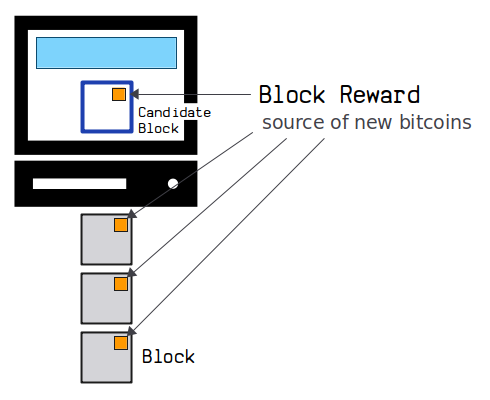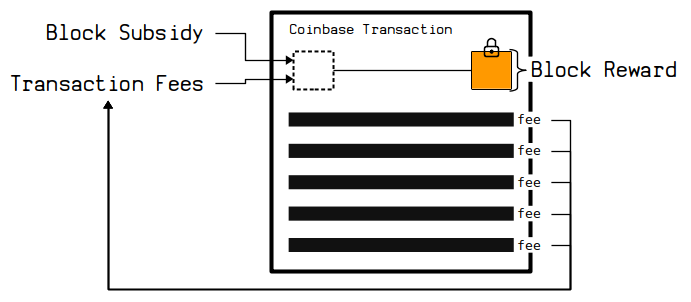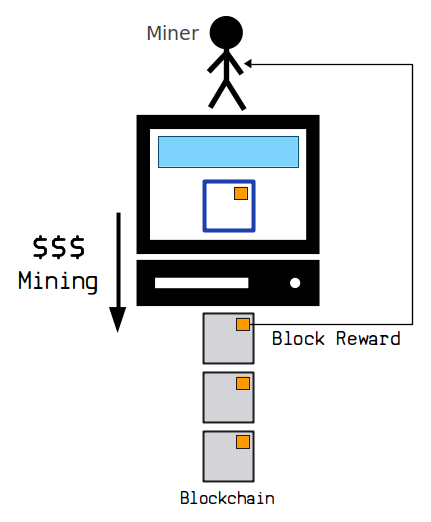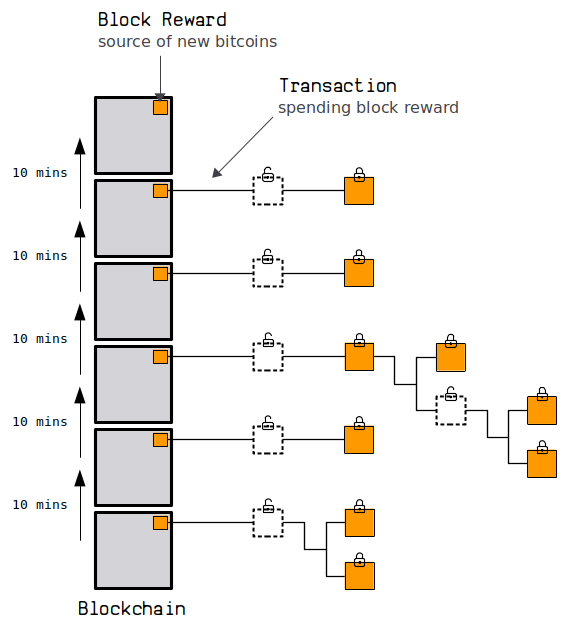Block Reward
Incentive for miners to mine blocks

The block reward is an amount of bitcoins that a miner can collect for mining a block.
It is claimed via the coinbase transaction, and provides an incentive for miners to mine new blocks on to the blockchain.
Source
Where does the block reward come from?

The block reward consists of two parts:
1. Block Subsidy
The block subsidy is a set amount of new bitcoins that a miner is allowed to send themselves for mining a block.
The size of the block subsidy is based on the height of the block.
See halving section for a full table of past, current, and future block subsidies.
2. Transaction Fees
The block reward also consists of all the fees from the transactions included in the block.
A transaction fee is an amount of bitcoin that doesn't get "used up" in a transaction, and a miner is able to claim these "left over" bitcoins as part of the block reward too.
Miners fill their candidate blocks with transactions from the memory pool that contain the highest fees on them to maximize the amount of bitcoins they can claim from the block reward. Therefore, setting a high fee on a transaction acts as an incentive for miners to include your transaction in their next block.
The incentive can also be funded with transaction fees. If the output value of a transaction is less than its input value, the difference is a transaction fee that is added to the incentive value of the block containing the transaction.
The block reward will be made up entirely of transaction fees when there's no more block subsidy left.
Purpose
What is the purpose of the block reward?
The block reward serves two purposes:
1. Incentive

As already mentioned, the block reward provides an incentive for miners to add new blocks on to the blockchain.
It requires energy to try and mine new blocks on the blockchain, so the block reward compensates miners for the processing power they use during mining.
And if the block reward is substantial enough, it encourages more miners to join the network to help build the blockchain, which in turn makes the blockchain even more secure (as it would require more energy for a single miner to attempt to rewrite the blockchain).
2. Distribution

The block reward (well, the block subsidy) is used to distribute new bitcoins in to the network.
Bitcoin is a decentralized currency, which means there's no central "bank" to control the amount of new bitcoins that enter the network, or who they get sent to. Therefore, new bitcoins enter the network via the mining process, which means that new bitcoins are issued are regular intervals, and any miner can be in with a chance of claiming them.
The [block subsidy] provides a way to initially distribute coins into circulation, since there is no central authority to issue them.
Halving
What is "the halvening"?
The block subsidy started at 50 BTC, and it halves every 210,000 blocks (roughly every 4 years).
This creates a fixed supply of bitcoin, where the issuance of new coins diminishes over time until it reaches zero.
Table
This table show the dates and amounts for previous and upcoming Bitcoin halvings. The current block subsidy is highlighted.
Current Height: 841,071
| Halving | Height | Subsidy (BTC) | Date | Total Mined (BTC) |
|---|---|---|---|---|
| 0 | 0 | 50.00000000 | 0.00000000 | |
| 1 | 210,000 | 25.00000000 | 10,500,000.00000000 | |
| 2 | 420,000 | 12.50000000 | 15,750,000.00000000 | |
| 3 | 630,000 | 6.25000000 | 18,375,000.00000000 | |
| 4 | 840,000 | 3.12500000 | 19,687,500.00000000 | |
| 5 | 1,050,000 | 1.56250000 | 17 Apr 2028 (estimate) | 20,343,750.00000000 |
| 6 | 1,260,000 | 0.78125000 | 14 Apr 2032 (estimate) | 20,671,875.00000000 |
| 7 | 1,470,000 | 0.39062500 | 11 Apr 2036 (estimate) | 20,835,937.50000000 |
| 8 | 1,680,000 | 0.19531250 | 09 Apr 2040 (estimate) | 20,917,968.75000000 |
| 9 | 1,890,000 | 0.09765625 | 06 Apr 2044 (estimate) | 20,958,984.37500000 |
| 10 | 2,100,000 | 0.04882812 | 03 Apr 2048 (estimate) | 20,979,492.18750000 |
| 11 | 2,310,000 | 0.02441406 | 01 Apr 2052 (estimate) | 20,989,746.09270000 |
| 12 | 2,520,000 | 0.01220703 | 29 Mar 2056 (estimate) | 20,994,873.04530000 |
| 13 | 2,730,000 | 0.00610351 | 26 Mar 2060 (estimate) | 20,997,436.52160000 |
| 14 | 2,940,000 | 0.00305175 | 24 Mar 2064 (estimate) | 20,998,718.25870000 |
| 15 | 3,150,000 | 0.00152587 | 21 Mar 2068 (estimate) | 20,999,359.12620000 |
| 16 | 3,360,000 | 0.00076293 | 18 Mar 2072 (estimate) | 20,999,679.55890000 |
| 17 | 3,570,000 | 0.00038146 | 16 Mar 2076 (estimate) | 20,999,839.77420000 |
| 18 | 3,780,000 | 0.00019073 | 13 Mar 2080 (estimate) | 20,999,919.88080000 |
| 19 | 3,990,000 | 0.00009536 | 10 Mar 2084 (estimate) | 20,999,959.93410000 |
| 20 | 4,200,000 | 0.00004768 | 08 Mar 2088 (estimate) | 20,999,979.95970000 |
| 21 | 4,410,000 | 0.00002384 | 05 Mar 2092 (estimate) | 20,999,989.97250000 |
| 22 | 4,620,000 | 0.00001192 | 02 Mar 2096 (estimate) | 20,999,994.97890000 |
| 23 | 4,830,000 | 0.00000596 | 01 Mar 2100 (estimate) | 20,999,997.48210000 |
| 24 | 5,040,000 | 0.00000298 | 27 Feb 2104 (estimate) | 20,999,998.73370000 |
| 25 | 5,250,000 | 0.00000149 | 24 Feb 2108 (estimate) | 20,999,999.35950000 |
| 26 | 5,460,000 | 0.00000074 | 22 Feb 2112 (estimate) | 20,999,999.67240000 |
| 27 | 5,670,000 | 0.00000037 | 19 Feb 2116 (estimate) | 20,999,999.82780000 |
| 28 | 5,880,000 | 0.00000018 | 16 Feb 2120 (estimate) | 20,999,999.90550000 |
| 29 | 6,090,000 | 0.00000009 | 14 Feb 2124 (estimate) | 20,999,999.94330000 |
| 30 | 6,300,000 | 0.00000004 | 11 Feb 2128 (estimate) | 20,999,999.96220000 |
| 31 | 6,510,000 | 0.00000002 | 08 Feb 2132 (estimate) | 20,999,999.97060000 |
| 32 | 6,720,000 | 0.00000001 | 06 Feb 2136 (estimate) | 20,999,999.97480000 |
| 33 | 6,930,000 | 0.00000000 | 03 Feb 2140 (estimate) | 20,999,999.97690000 |
Total Supply: 20,999,999.9769 BTC
Code
Here's some simple Ruby code for calculating the block subsidy based on block height.
# function for calculating the subsidy for a given height (in satoshis)
def subsidy(height)
# calculate how many halvings there have been based on the height
halvings = height / 210000 # halving is every 210,000 blocks
# set the starting block subsidy
subsidy_initial = 5000000000 # 50 BTC in satoshis
# calculate the current block subsidy based on the height
subsidy_current = subsidy_initial >> halvings # bit shift right for every halving
# TIP: A right bit shift is a quick and easy way to divide by 2 (rounded down)
return subsidy_current
end
# get block subsidy for a specific height
puts subsidy(300000) #=> 250000000 sats
The actual code for the halving can be found in validation.cpp (search for GetBlockSubsidy)
Bit Shift
The halving is actually a right bit shift.
This is pretty much the same as dividing by 2, except the result of division is rounded down if the starting number is odd.
You can see what I mean by entering 5000000000 (the initial block subsidy in satoshis) in to the decimal field of the base converter tool below, and then removing the rightmost bits from the binary field (which is equivalent to performing a right bit shift):
So instead of calling it "the bitcoin halving", it could be more affectionately referred to as "the bitshift righting".
Examples
Here are few examples of block rewards from previous blocks in the blockchain:
- Height: 100
- Block Reward: 50 BTC
- Block Subsidy: 50 BTC
- Transaction Fees: 0 BTC
-
This is one of the earliest blocks. It claimed the maximum 50 BTC block subsidy, but there were no transactions included in the block (other than the coinbase transaction), so no transaction fees could be claimed on top of the block subsidy.
- Height: 2,817
- Block Reward: 52.01 BTC
- Block Subsidy: 50 BTC
- Transaction Fees: 2.01 BTC
-
This was the first block that collected transaction fees as part of the block reward. It was completely unnecessary for the transactions in this block to pay fees, but nonetheless it's the first example of a miner collecting fees along with the block subsidy.
- Height: 100,000
- Block Reward: 50 BTC
- Block Subsidy: 50 BTC
- Transaction Fees: 0 BTC
-
This block contains 3 transactions (not including the coinbase transaction). However, there wasn't much competition to get into a block during this time, so transactions didn't need to include a fee to get mined.
- Height: 124,724
- Block Reward: 49.99999999 BTC
- Block Subsidy: 50 BTC
- Transaction Fees: 0.01 BTC
-
This is an example of a block not claiming the full block reward. This particular block did not claim the maximum available subsidy of 50 BTC, nor did it claim the transaction fee of 0.01 BTC also available.
So it's perfectly valid for a miner to not claim the full block reward within their coinbase transaction, although this is usually due to an error on the miner's part.
- Height: 210,000
- Block Reward: 38.56295554 BTC
- Block Subsidy: 25 BTC
- Transaction Fees: 13.56295554 BTC
-
This was the first halving block. The block subsidy was halved from 50 BTC to 25 BTC.
- Height: 788,695
- Block Reward: 12.95074657 BTC
- Block Subsidy: 6.25 BTC
- Transaction Fees: 6.70074657 BTC
-
This was the first block where the size of the transaction fees was greater than the block subsidy.
Spending
When can you spend the block reward?
The block reward can only be spent by a miner when the block reaches over 100 blocks deep in the blockchain.
See coinbase maturity.
Notes
-
A miner does not have to claim the block reward. There is no reason why they wouldn't, but there's nothing stopping a miner from not claiming the full block reward if they do not want to. In this situation the bitcoins would be lost forever, as there would be no way to spend those bitcoins in a future transaction. For example, the block reward for block 501,762 was 12.5 BTC, but the miner didn't send themselves any bitcoin in the coinbase transaction for that block, so those bitcoins are lost forever. This was most likely a mistake.
-
The block subsidy is often mistakenly referred to as the "block reward". It's common to see the new bitcoins referred to as the block reward, but technically speaking the block reward is made up of the block subsidy (the new bitcoins) + transactions fees. I don't think it's going to cause you any problems if you get it wrong, but I just thought I'd mention as I've made this mistake in the past.
-
The term "block reward" was not used in the whitepaper. Satoshi only referred to mining reward as being an incentive, and didn't use the term "block reward" until over a year later on the bitcointalk forums. Just a fun fact for your next pub quiz.
-
The total supply of bitcoin is 20,999,999.9769 BTC. So it's technically less than the "21 million cap" you keep hearing about. This is due in part to the fact that the halving is a right bit shift, which means that the block subsidy gets rounded down if the previous block subsidy was an odd number. Again, another great night at the pub quiz.